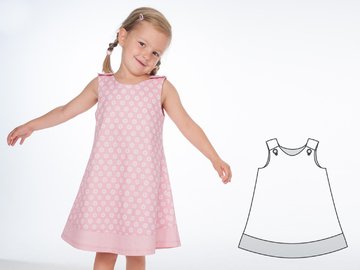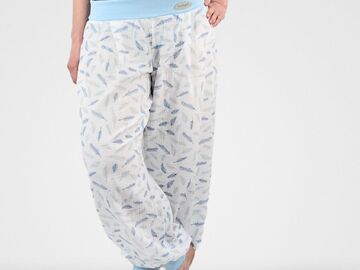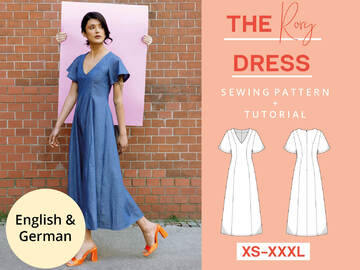Do you dream of giving your home or a loved one something magical? With this sewing tutorial, you can sew an enchanting little plush dragon yourself! Whether as a gift for children, a personal DIY project, or a charming eye-catcher in your living room—this fabric dragon is guaranteed to capture hearts.
In this blog post, I’ll show you step by step how to create your own unique dragon using a free pattern, an easy-to-follow guide, and a little patience. Whether you’re a beginner or a seasoned sewing enthusiast, you’ll find practical tips on fabric selection, sewing, and stuffing to make your dragon perfect.
So, grab your sewing machine and let’s get started—your new cuddly friend is already waiting!
f(1).png)
Materials List:
-
Nicky fleece in green (you can also use other fabrics; even non-stretchable fabrics are suitable)
-
Cotton fabric (e.g., muslin) in dark blue
-
Matching sewing thread
-
Stuffing material
-
Scissors and pinking shears
-
Embroidery thread or fabric marker
-
Fabric marking pen or chalk
-
Safety eyes (9 mm) or embroidery thread
Note before getting started: What is fabric nap?
(1)(1).png)
Nicky fleece has a “nap.” When you run your hand over the fabric, one direction feels smooth and soft, the other rough. My pattern pieces are designed so the dragon feels as smooth as possible when cuddled, so make sure to pay attention to the nap!
For other fabrics like Alpine fleece and cotton Nicky, there usually isn’t a nap, so you can align the nap with the grainline!
Preparing the Pattern
First, print the pattern, which you can find here in the “Free” section. Make sure the scaling is set to 100% and that “No Borders” is selected under “Borders.” After printing, check that the measurements are correct using the control square.
Cut out all the pattern pieces along the dashed lines. Note that seam allowances are already included for the back spikes but not for other pieces. Attach the back spikes and body pieces at the indicated glue areas to create the following layout:
.png)
Transfer the pieces onto the fabric using a fabric marker or chalk. Trace the body once and the wings twice in mirrored pairs. Add your individual seam allowance and cut out the pieces. Transfer the markings for ears, back spikes, wings, arms, legs, and the face onto the right side of the fabric.
You should now have the following pieces:
-
2 mirrored wings in green and 2 mirrored wings in blue
-
2 mirrored ears in green and 2 mirrored ears in blue
-
4 feet in blue
-
4 arms in blue
-
2 back spikes in blue
-
2 body pieces in green
(5).png)
Sewing the Pieces
Pin the wings (1 green, 1 blue), ears (1 green, 1 blue), arms, and legs together, right sides facing. Sew around each piece, leaving a turning opening along the straight edge. Use a straight stitch with a length of 2 mm unless otherwise stated.
(2)(1).png)
For the back spikes, roughly cut them out and sew along the marked seam line.
(5).png)
Tips for sewing the spikes neatly:
Sew carefully up to each corner (you can use the handwheel if necessary), leave the needle in the fabric, lift the presser foot, and pivot the fabric. Lower the presser foot and continue sewing to the next corner.
b(1).png)
Once everything is sewn together, the seam allowances are trimmed back. Ideally, you should use pinking shears to prevent fraying.
This is what it looks like before trimming:
(5).png)
And this is what it looks like afterwards:
(5).png)
Next, clip the seam allowance, especially along the inward curves of the wings and back spikes, cutting close to but not through the seam. Trim the seam allowance on the ears, legs, and arms, and clip those as well.
(4).png)
(3).png)
Turn all the pieces right-side out and shape them well. If using cotton fabric, you can press the seams—especially for the spikes—to relax the fabric and help it lie flat. Trim the seam allowances at the turning openings of the wings, ears, arms, and legs for a clean edge.
This is what it looks like before trimming:
(7).png)
And this is what it looks like afterwards:
(3).png)
Assembling the Dragon
Lay the individual parts onto the right side of the body at the marked positions and pin them in place. Attach them using a zigzag stitch with a stitch length of 0.5 mm and a width of 5 mm. Ensure the stitch passes through both the body and the attached part (wing, arm, ear) on one side, and only through the body on the other. This way, the attachment points won’t be visible after sewing.
d(1).png)
For the eyes, make a tiny hole at the marked spot (or use a thick yarn needle to push apart the fabric threads). If you have felt, place it on the backside of the fabric for extra stability, or use a piece of sturdier fabric. Secure the safety eyes with their backings.
(2).png)
(1).png)
If you prefer not to use safety eyes, embroider the eyes with black thread using a French knot stitch at the marked positions.
Pin the back spikes right sides together onto one body piece, starting from the marking on the head and aligning them down the back. To prevent shifting later, sew the spikes in place using a zigzag stitch (to maintain stretchability) with a stitch length and width of 5 mm within the seam allowance.
(1).png)
Stuff the feet lightly with stuffing material and pin them to the marked positions.
(1).png)
(1).png)
Fold the wings and ears onto the body so they don’t get caught in the side seams.
(1).png)
Lay the second body piece right side down on top, aligning the edges, and pin them together. Sew around the edges along the marked seam line, leaving a turning opening at the belly. Take extra care at the tail spikes to ensure they don’t get caught in the bottom tail seam!
(3)(1).png)
After sewing, clip the seam allowances at all curves and corners, then turn the dragon right-side out. Check that all seams are secure and shape the curves neatly. You won’t be able to fully turn the tail, but this ensures the spikes reach all the way to the tip.
Stuff the dragon with filling and close the belly opening using a ladder stitch.
(3).png)
Finally, embroider the nostrils and mouth with black thread.
(1).png)
And you’re done!
I hope you enjoyed this tutorial. If you have questions or run into issues, please leave a comment! I’d also love to hear your positive feedback :)
Happy sewing! Feel free to check out my other free blog posts or browse my shop for more sewing and crochet patterns for practical items, adorable plushies, and Amigurumi.





























































































































































